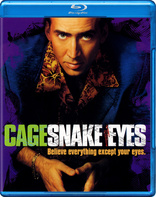Snake Eyes Blu-ray Movie
HomeSnake Eyes Blu-ray Movie 
Warner Bros. | 1998 | 98 min | Rated R | Sep 10, 2013Movie rating
6.4 | / 10 |
Blu-ray rating
| Users | 3.8 | |
| Reviewer | 4.0 | |
| Overall | 3.9 |
Overview
Snake Eyes (1998)
A shady police detective finds himself in the middle of a murder conspiracy at an important boxing match in an Atlantic City casino.
Starring: Nicolas Cage, Gary Sinise, John Heard, Carla Gugino, Stan ShawDirector: Brian De Palma
| Crime | Uncertain |
| Thriller | Uncertain |
| Mystery | Uncertain |
Specifications
Video
Video codec: MPEG-4 AVC
Video resolution: 1080p
Aspect ratio: 2.40:1
Original aspect ratio: 2.39:1
Audio
English: DTS-HD Master Audio 5.1 (48kHz, 24-bit)
French: Dolby Digital 2.0
Spanish: Dolby Digital 2.0
Subtitles
English SDH, French, Spanish
Discs
25GB Blu-ray Disc
Single disc (1 BD)
Playback
Region free
Review
Rating summary
| Movie | 4.0 | |
| Video | 4.5 | |
| Audio | 4.5 | |
| Extras | 0.5 | |
| Overall | 4.0 |
Snake Eyes Blu-ray Movie Review
The Dice Are Loaded
Reviewed by Michael Reuben September 6, 2013The career of director Brian De Palma provides an object lesson in the vagaries of the film industry. Scarface (1983) was protested, critically reviled and a box office disappointment, but today it is considered a gangster classic and is among the films for which De Palma will be remembered. The success of The Untouchables (1987) got De Palma the clout to bring his long-planned passion project, Casualties of War (1989), to the screen, but the film was little seen and remains one of his least known (though one of his best). And as a reward for suffering through exhausting battles with producer and star Tom Cruise to craft the first (and still the best) Mission: Impossible film, Paramount funded Snake Eyes, nominally a conspiracy thriller, with a screenplay by Mission: Impossible co-scribe David Koepp from a story by Koepp and De Palma. Under the thriller surface, though, De Palma was more interested in something else, just as he'd pursued other interests in horror-themed films like Carrie and Dressed to Kill. In Snake Eyes, De Palma placed the viewer into a surveilled environment, Atlantic City, where everyone knows they're being watched, and he followed a protagonist, a local cop, who thinks he has the place under control. Then De Palma systematically deconstructed both the surveillance and the cop's certainty, taking his camera into places where the eye can't normally see, distorting perspective and ripping apart all the cop's certainties. The result, though not to every viewer's taste, draws a stark contrast with the usual Hollywood formula. As he routinely has done throughout his career, De Palma tried to make cinema interesting, starting with Snake Eyes' attention-grabbing opening shot that lasts an unbroken thirteen-plus minutes. (In fact, it contains multiple edits, but they're masterfully concealed.) The film's reception was less than friendly. Many viewers complained that the trailer gave away too much. Others carped that the film gave away too much by revealing the villain too early (to which De Palma promptly replied, in vain, that the villain's identity wasn't the point). Few saw the film as a stylized tale of a flawed hero's journey to redemption, and even fewer remained through the entire end credit scroll to catch the wit of the closing shot. Snake Eyes might have gained in reputation since its theatrical release, if it had ever been given a decent video presentation, because it's a film where the widescreen visuals are so essential that any compromise deprives the film of its impact. But both Paramount's laserdisc and its DVD (which used the same transfer) were virtually unwatchable symphonies of edge enhancement, aliasing and video noise. The new Blu-ray released by Warner changes the game.
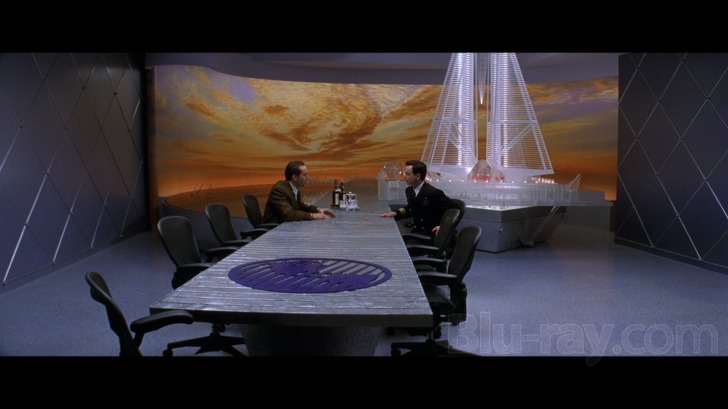
Nicolas Cage is perfectly cast as Atlantic City police detective Rick Santoro, a corrupt but fundamentally decent Good Time Charlie with a wife, a mistress, a bookie and a nose for cocaine. Rick loves the spotlight, likes to party and believes that everyone should come to Atlantic City and have a good time. Someday he might even run for mayor. Tonight Rick is in top form attending the heavyweight title match between champion Lincoln Tyler (Stan Shaw) and challenger Jose Pacifico Ruiz (Adam C. Flores). The fight is being held in the Atlantic City Arena, part of a casino and hotel complex owned by tycoon Gilbert Powell (John Heard). The event is a sort of farewell to the Arena, which is being torn down to make way for a bigger, better resort center that Powell intends to out-glitz everything in town. As Rick bounds up and down the aisles of the Arena, fending off calls from both his wife and his mistress, chatting with his bookie, waving to the champ (with whom he went to high school), you'd hardly know he was a cop on duty—but that's the Santoro style. Rick's childhood friend, U.S. Navy Commander Kevin Dunne (Gary Sinise), is also attending, because he's in charge of security for a major dignitary, Secretary of Defense Charles Kirkland (David Fabiani), who tells the news cameras he's just there to see the fight. In fact, Kirkland is mixing business with pleasure, because casino owner Powell is also a major defense contractor, and Kirkland has just come from the test of a new missile defense system, the AirGuard. As the fight begins, Rick and Dunne sit together in the first row, just in front of Secretary Kirkland, when Dunne's attention is caught by a redheaded woman (Jayne Heitmeyer) who looks "wrong". When Dunne asks to see her ticket, she runs and Dunne chases her, but then his empty seat is taken by another woman in a platinum blonde wig. We will later come to know her as Julia Costello (Carla Gugino), and she turns to speak to the Secretary. Suddenly—and I'm leaving out a few more events that are better seen than described—shots ring out and the Secretary falls to the ground. Julia Costello disappears into the panicking crowd. Dunne, who has now traversed the arena in pursuit of the redhead, zeroes in on the source of the shots and fires into a utility closet, killing the shooter. He will later be identified as a Palestinian extremist. Now, for all his faults, Rick Santoro is neither stupid nor incompetent. Even while the crowd is panicking around him, he's already spotted other oddities besides Dunne's mysterious redhead. As the senior cop on the scene, he insists on taking charge until federal authorities arrive, which might take some time, because there's a tropical storm raging outside that's threatening to intensify to hurricane force. (Tamara Tunie has some entertaining moments as a TV reporter forced to brave the winds to file her story.) But the further Rick digs, the more he discovers that he's violating expectations. He's supposed to live down to his reputation as a corrupt cop who doesn't ask questions and lets things slide, but Rick discovers, to his great frustration, that he can't do it. In one of the film's key exchanges, an innocent caught up in the deadly games asks Rick why he's so angry, and he barks back:
Because I didn't have to know! You decided to have this problem, not me! My world would've gone on turning just fine, but now, either way I look, I have to do something that I don't wanna do.Much of Snake Eyes is about Rick Santoro's world being torn apart: spiritually, by what he discovers about the people around him; visually, as De Palma's camera literally disassembles the sports and casino complex by moving through it in ways that are physically impossible; and narratively, as he replays key sequences you've already seen from a different point of view. In the original version of Snake Eyes, the building itself was to have been torn apart by a tidal wave created by Industrial Light and Magic, but the sequence was deleted after a preview. In the film's final cut, the building survives the storm, only to be torn down and rebuilt afterwards. The construction crews are working as the credits roll, and a montage of news footage has shown us the price that Rick Santoro paid for trying to do the right thing. De Palma has long been fascinated by the terrible toll exacted from those who try to behave honorably. It's a dominant theme in Casualties of War, and it runs through both The Untouchables and Carlito's Way. In Snake Eyes, one could fairly say that the lesson is written in stone.
Snake Eyes Blu-ray Movie, Video Quality 
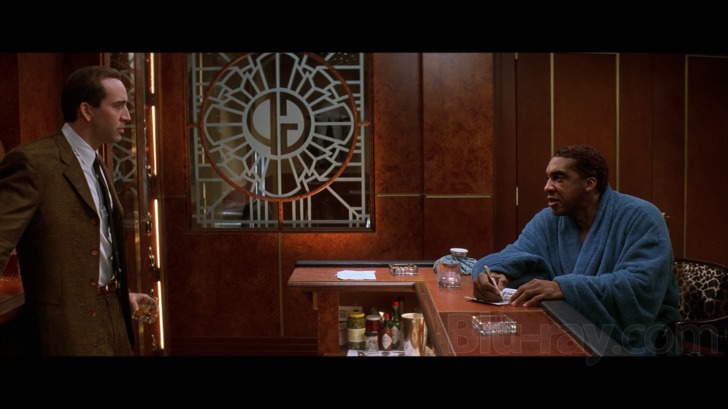
A scene occurs about thirty-seven minutes into Snake Eyes that perfectly exemplifies everything wrong with the prior video transfer created by Paramount for laserdisc and then recycled onto DVD. Rick Santoro and Kevin Dunne sits across the table from each other in a gaudy conference room, so that Rick can explain how he's uncovered a conspiracy in the shooting of the Defense Secretary. But on the DVD or LD, viewers often had trouble concentrating on the dialogue, because they were so distracted by the dancing pixels on the walls, conference table and the model of the planned new complex at the back of the room. The entire scene was alive with aliasing and video noise, and I have always wondered how any self-respecting telecine colorist could have allowed it to leave his or her workstation. Well, at long last that scene is watchable, along with everything else on the new transfer presented on Paramount/Warner's 1080p, AVC-encoded Blu-ray. Stephen H. Burum, the ace cinematographer who so fluidly followed Al Pacino through Grand Central Station in Carlito's Way, lit and photographed the insanely complicated tracking shots of which Snake Eyes is largely composed, and the Blu-ray reveals depth and detail in his work that haven't been visible since the film played in theaters. The blacks are deep, the colors are vivid and saturated, and the image pops with intensity at all the right moments (usually when something bad is about to happen; in De Palma's world, evil always looks great). Fine detail in faces, clothing and decor is readily apparent, even when the action speeds up. The average bitrate of 22.96 is on the low side, but I assume that's the result of an efficient compressionist trading off savings from scenes where De Palma slows down the action in order to have more bits for demanding moments like the "whip pans" that conceal the edits in long takes. In any case, unless one counts Rick Santoro's questionable wardrobe, artifacts were not an issue.
Snake Eyes Blu-ray Movie, Audio Quality 
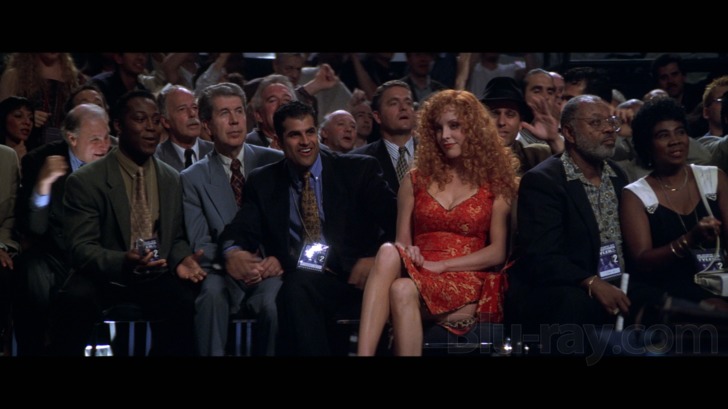
Snake Eyes's elaborately mixed soundtrack is presented in lossless DTS-HD MA 5.1, and it's full of subtle cues and shifts in perspective that follow De Palma's camera as it criss-crosses the Arena, the casino and the hotel complex. The crowd scenes during the boxing match and the roar of the intensifying storm—heard both from inside and, in a few key scenes, outside the buildings—are obvious showcases, but quieter detail emerges on repeat viewings. Listen, for example, to the individual environments as the camera passes overhead from one hotel room to another looking for Julia Costello and the conventioneer in whose room she's taken refuge. Each room has a distinct sonic character, and they ease from one to another so smoothly that the transitions are seamless instead of gimmicky. The dialogue remains clear regardless of the surrounding din, and the score by Ryûichi Sakamoto (an Oscar winner for The Last Emperor) has been carefully balanced to coordinate with the environment (unlike the Pino Donnagio scores in De Palma's early films, which sometimes took over the soundtrack altogether).
Snake Eyes Blu-ray Movie, Special Features and Extras 
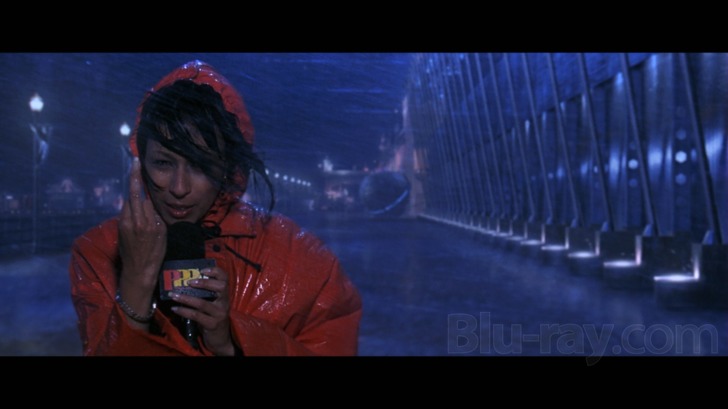
Like Paramount's 1999 DVD, the Blu-ray has no extras other than a trailer (480i; 1.85:1; 2:26).
Snake Eyes Blu-ray Movie, Overall Score and Recommendation 
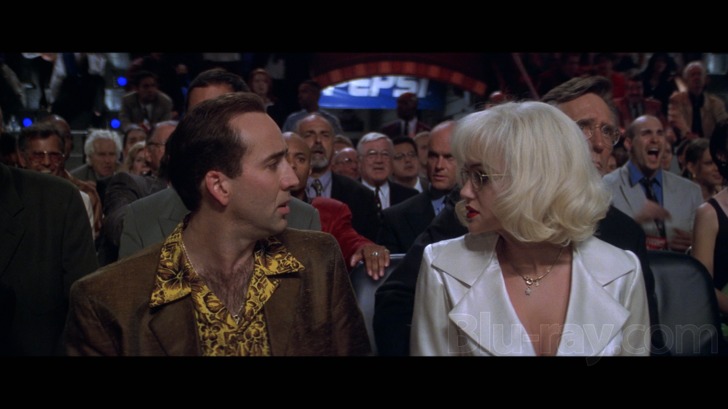
For anyone new to Snake Eyes, I recommend it, as long as you don't approach the film as a "who done it" or even a "why did they do it". It's a film about a flawed hero who has to make a choice, and it presents his problem with a visual flair unlike anything you're likely to encounter in other movies. Whether the style will be to your taste is something I can't promise, but at least now you can see it for the first time in fifteen years. Highly recommended.
Other editions
Snake Eyes: Other Editions
Similar titles
Similar titles you might also like

Sea of Love 4K
1989

State of Play
2009

Righteous Kill
2008

Edge of Darkness
2010

Kill the Irishman
2011

Hangman
2017

Fracture
2007

Presumed Innocent
1990

Knox Goes Away
2023

The Trust
2016

The Bone Collector 4K
1999

Sherlock Holmes Faces Death
1943

Twisted
2004

Dexter: The Third Season
2008

Harry Brown
2009

Murder at 1600
1997

Gone Baby Gone
2007

Broken City
2013

The Drop
2014

The Two Jakes 4K
1990
